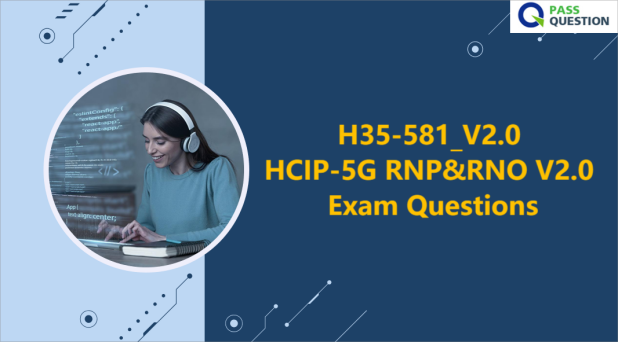H35-581_V2.0 HCIP-5G RNP&RNO V2.0 Exam Questions
Are you in search of comprehensive online study material for the H35-581_V2.0 HCIP-5G RNP&RNO V2.0 Exam? PassQuestion offers the latest H35-581_V2.0 HCIP-5G RNP&RNO V2.0 Exam Questions that cover all the essential topics you need to excel in your exam. By utilizing our H35-581_V2.0 HCIP-5G RNP&RNO V2.0 Exam Questions, you will not only be well-prepared for your exam but also increase your chances of achieving a high score in the H35-581_V2.0 HCIP-5G RNP&RNO V2.0 Exam. Don't miss out on this opportunity to enhance your knowledge and boost your exam performance. Get started with PassQuestion today!

HCIP-5G-RNP&RNO Certification
Holding the HCIP-5G-RNP&RNO Certification demonstrates your expertise in performing Huawei 5G radio network planning and cell parameter design. It also showcases your ability to evaluate and apply network optimization features, effectively manage radio network performance, and conduct thorough analysis and optimization of performance.
To pursue the HCIP-5G-RNP&RNO Certification, it is essential to have a solid understanding of one type of mobile communication network (2G/3G/4G). Additionally, you should have a clear grasp of the basic concepts of 5G and be familiar with Huawei's 5G base station products and their fundamental operations. It is crucial to demonstrate proficiency in carrying out essential operations and conducting service tests on 5G networks.
By obtaining the HCIP-5G-RNP&RNO Certification, you will not only validate your expertise in the field but also enhance your career prospects. This certification serves as a testament to your advanced knowledge and skills in the domain of Huawei 5G radio network planning and optimization, positioning you as a valuable asset in the industry.
Ensure that you are well-prepared and equipped with the necessary knowledge and practical experience to excel in the HCIP-5G-RNP&RNO Certification examination. This comprehensive certification will enable you to tackle complex challenges in the 5G network domain, further establishing your reputation as a competent professional in the field.
HCIP-5G RNP&RNO V2.0 Exam Overview
Exam Code: H35-581
Certification: HCIP-5G RNP&RNO
Exam Name: HCIP-5G RNP&RNO V2.0
Exam Format: Single-answer Question, Multiple-answer Question, True or false
Time: 90min
Passing Score/Total Score: 600/1000
Exam Cost: 300USD
Language: Chinese, English
HCIP-5G RNP&RNO V2.0 Exam Knowledge Points
5G Radio Network Indepth Principles (30%)
1. 5G air interface principles
2. 5G protocol and signaling analysis
5G Radio Network Planning (10%)
1. 5G wireless network coverage and capacity estimation
2. 5G radio network cell parameters design
3. 5G radio network planning simulation
5G RAN Feature Application (35%)
1. 5G physical channel management feature
2. 5G power control feature
3. 5G scheduling feature
4. 5G mobility management feature
5. 5G Massive MIMO feature
6. 5G beam management feature
7. 5G voice services solution
8. Interoperability between E-UTRAN and NG-RAN
9. 5G radio network performance management
5G Radio Network Optimization (20%)
1. 5G radio network coverage problem analysis
2. 5G radio network access problem analysis
3. 5G radio network handover problem analysis
4. 5G radio network call drop problem analysis
5. 5G radio network data transmission and RANK problem analysis
5G Industry Applications and Solutions (5%)
1. 5G industry applications and solutions
View Online Huawei HCIP-5G-RNP&RNO V2.0 H35-581_V2.0 Free Questions
1. Which of the following NAS messages will carry QFI parameters?
A. Registration Request
B. Registration Accept
C. PDU Session Establishment Request
D. PDU Session Establishment Accpet
Answer: D
2. Regarding 5G wireless coverage planning, which of the following statements is incorrect?
A. In general scenarios, 5G coverage is limited by the uplink service channel
B. In low-frequency scenarios, there is generally no need to consider the impact of rain and snowfall.
C. The higher the edge continuity rate required by the planning, the larger the cell coverage radius will be.
D. Under normal circumstances, the shadow fading margin in dense urban areas is greater than the shadow fading margin in rural areas.
Answer: C
3. Which changes in 5G have the greatest impact on operation and maintenance?
A. Network cloudification
B. Network slicing
C.SDN
D. Microservices
Answer: ABCD
4. Which of the following are GBR parameters of 5G?
A.GFBR
B. Session-AMBR
C.MFBR
D.UE-AMBR
Answer: AC
5. Which of the following are the differences between 5G TDD and FDD in the link budget process?
A. FDD uses different propagation models
B. Low-frequency FDD networks need to reserve higher interference margins
C. FDD usually does not consider massive MIMO shaping gain
D. FDD needs to consider antenna feeder loss
Answer: BC
6. Which of the following descriptions of the downlink scheduling process are correct?
A. The MCS calculation during the scheduling process requires CQ reporting.
B. Downlink scheduling requires the terminal to initiate a request
C. When the network PRB utilization rate is high, it is recommended to enable the interference randomization feature to reduce interference.
D. gNB determines whether to perform retransmission scheduling based on the UE's HARQ feedback information.
Answer: ACD
7. In the early stages of 5G network construction, what are the following main goals for wireless network optimization?
A. PRB utilization optimization
B. Switching performance optimization
C. Optimize wireless coverage
D. Throughput optimization
Answer: BCD
8. What factors need to be considered when estimating the capacity of a 5G cell?
A. Cell bandwidth
B. Terminal type
C. Maximum number of Massive MIMO multiplexing layers
D. Distribution of terminals
Answer: ACD
9. What functions can edge cloud computing achieve on 5G networks?
A. Wireless network DU function
B. Without network CU function
C. Core network functions
D. Business application functions
Answer: BCD
10. Which of the following are the architectural features of 5G core network?
A. Fully integrated cloud network
B. Service-oriented architecture
C. Distributed architecture
D. End-to-end network slicing
Answer: ABCD
- TOP 50 Exam Questions
-
Exam
All copyrights reserved 2025 PassQuestion NETWORK CO.,LIMITED. All Rights Reserved.

